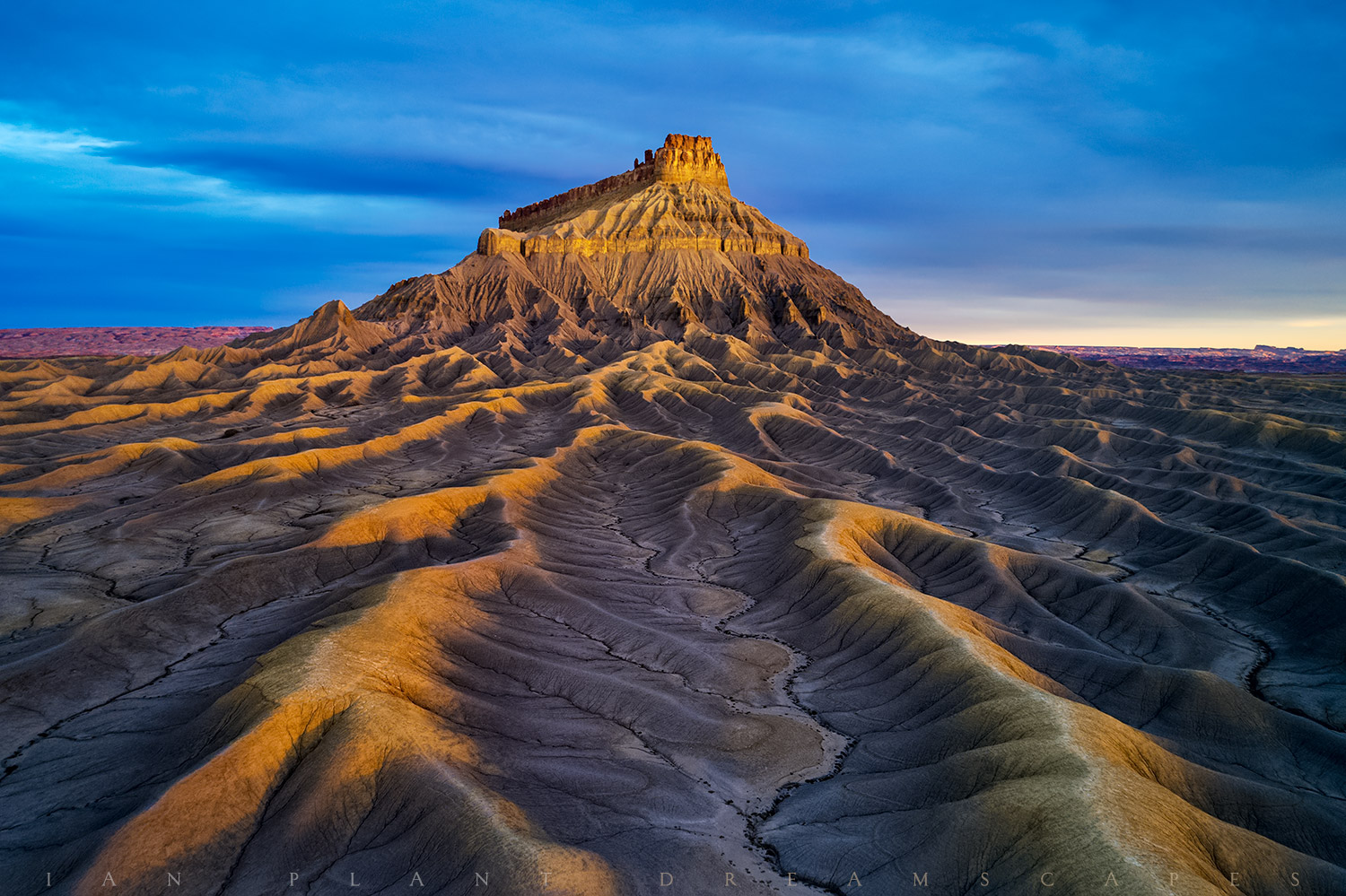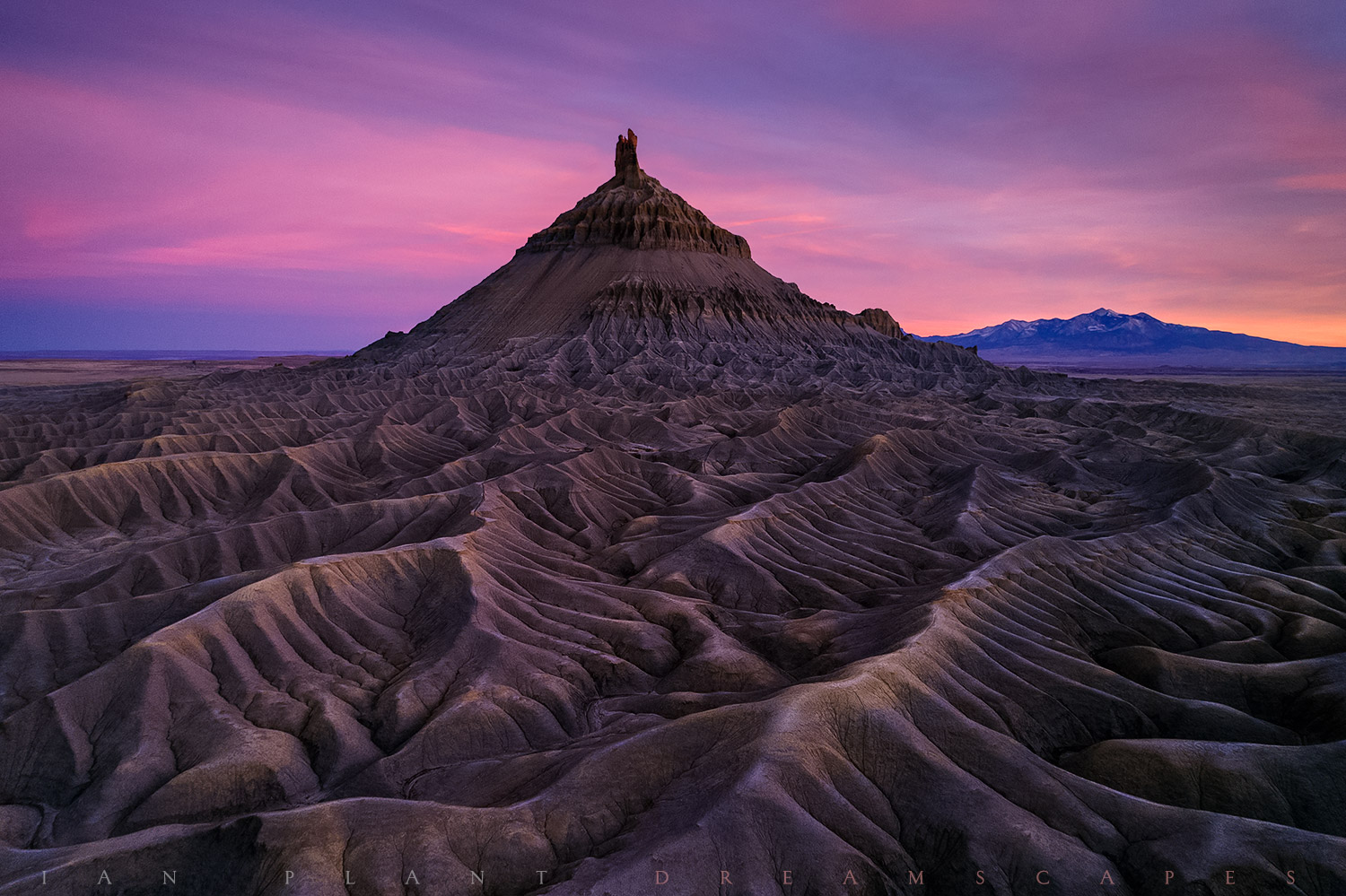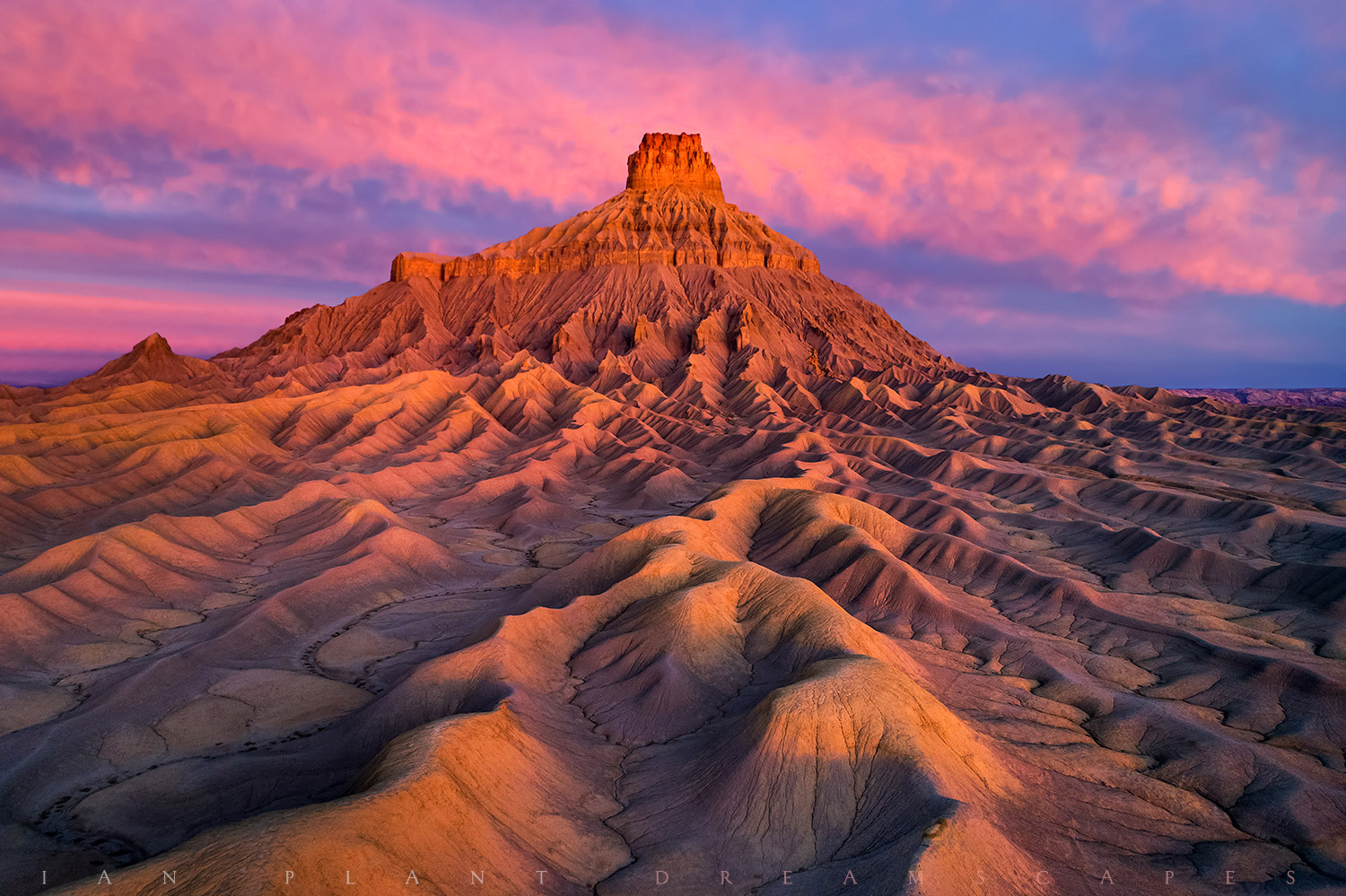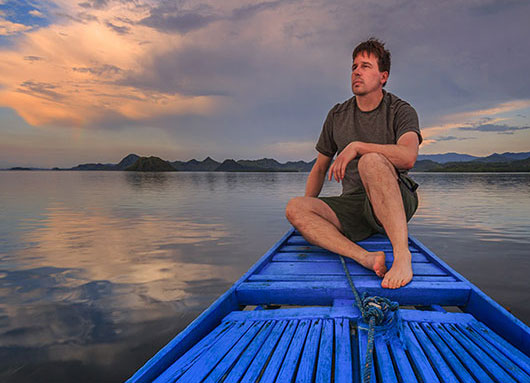In the past, I’ve written and spoken a lot about how planning for landscape photography requires a lot of scouting, and patience. During a recent photo trip to the desert of the American Southwest, I put all three to work while photographing the dramatic badlands found around Caineville, Utah.
I started by pouring over satellite maps, looking for interesting landforms to photograph. I was especially interested in doing some drone photography, so I was looking for patterns and colors that would be revealed from above. I quickly became attracted to several towering mesas surrounding the small town of Caineville, creating sprawling badlands that the locals refer to as the “moonscape area.” Excited by the possibilities, I hopped in my car and started a 20-hour drive to this area!
When I arrived, I began scouting using my vehicle and on foot. Although I was looking for aerial compositions, I was able to provisionally judge the potential of an area from the ground. I spent over a week exploring and photographing this alien landscape, hoping for some incredible light and color at sunrise and sunset. During that time, I got some favorable weather conditions, leading to several chances to make photographs with great light.
My first opportunity came at sunrise after clouds had rolled in overnight. The entire sky was overcast, except for a narrow sliver on the eastern horizon. Although the clouds didn’t catch any color, for a few minutes the rising sun bathed the landscape in a brilliant yellow light. I had good light on the landscape, and interesting clouds, but I didn’t get the color in the sky I was hoping for.
Clouds persisted throughout the day, and sunset looked like it was going to be dreary. Luckily, a patch in the western sky suddenly appeared, so I launched my drone and began looking for interesting compositions. The sky turned pink and purple as the sunset progressed into twilight, just as I got my drone into position over a place I had previously scouted by air. I started shooting as the sunset color peaked, experimenting with several different compositions until the color disappeared. The color in the sky was really nice, but the light on the landscape wasn’t particularly strong. The result is a perfectly nice photo, but I was aiming for something more compelling.
The clouds continued to build overnight, and it got very cold. The next morning was well below freezing, so I knew it was going to be tough to fly my drone. But, once again, there was a gap in the clouds on the eastern horizon, so I launched the drone, hoping that my fingers wouldn’t freeze too much while operating the remote controller. It’s a good thing that I did: all of my planning, scouting, and patience finally paid off, and I was rewarded with a spectacular sunrise. The clouds in all directions lit up with brilliant color, which was in turn reflected down onto the alien landscape below, painting the scene with a surreal palette. After many days of exploration and experimentation, and several sessions with colorful light, I finally had the photo I had been hoping for all along.
Although luck is obviously an important variable when making landscape photos, fortune favors those who plan, and the more time you spend in the field, the better your chances are that some good luck will head your way. With planning and persistence, you’ll eventually be able to turn your photo dreams into reality.
To read more about Ian’s Ethiopia trip, see:
Trip Report: Simien Mountains National Park, Ethiopia
Trip Report: Danakil Depression, Ethiopia
Trip Report: Rock-Hewn Churches of Ethiopia’s Tigray Region
About the author: Whether hanging over the rim of an active volcano, braving the elements to photograph critically-endangered species, or trekking deep into the wilderness to places most people will never see, world-renowned professional photographer Ian Plant travels the globe seeking out amazing places and subjects in his never-ending quest to capture the beauty of our world with his camera. Ian is a frequent contributor to many leading photo magazines, Managing Editor of Outdoor Photography Guide, a Tamron Image Master, and the author of numerous books and instructional videos. Known for his inspiring images and single-minded dedication to creating the perfect photo, Ian has reached hundreds of thousands of people around the world in his mission to inspire and educate others in the art of photography. You can see more of his work at www.ianplant.com.
Have something to add to the story? Leave a comment or email editor@outdoorphotographyguide.com.

Premium Membership
Unlock exclusive member content from our industry experts.
- 24/7 Access to Premium Photography Videos, Tips, and Techniques
- Step-by-Step Instructional Demos and Guides
- 50% Off Video Downloads Purchased in the Outdoor Photography Guide Shop
- Access to Ask the Expert Program
Unlock exclusive member content from our industry experts.
- 24/7 Access to Premium Photography Videos, Tips, and Techniques
- Step-by-Step Instructional Demos and Guides
- 2 Full-Length Video Downloads to Watch Offline
- 50% Off Video Downloads Purchased in the Outdoor Photography Guide Shop
- Access to Ask the Expert Program
Gold Membership
$463 Value
Get everything included in Premium plus exclusive Gold Membership benefits.
- 24/7 Access to Premium Photography Videos, Tips, and Techniques
- Step-by-Step Instructional Demos and Guides
- 8 Full-Length Video Downloads to Watch Offline
- 2 Full-Length Photography Classes to Keep for Life
- "How to Shoot Creatively" Educational Track
- Discounts on Purchase-to-Own Content in the Outdoor Photography Guide Shop
- Access to Ask the Expert Program
- Exclusive GOLD LIVE Streaming Events




Ian, my wife and I really love your photography and are inspired to try to get some images like these, especially since we have camped and photographed before in the Caineville Badlands area. We just got a Mavic 2 Pro drone, and are planning on returning around the end of September, where we hope to have some cooperating sunrises and/or sunsets for some drone photography. We understand and admire the great effort and perseverance on your part that is necessary to get these wonderful images, and will think about that every time we need to arise and travel in the dark to be in the right location to get that magic light!
Really great article. Thanks for taking the time to explain things in such great detail in a way that is easy to understand.
Ian, loved your classes on the Badlands and Leprechaun Canyon and your one on bracketing and focus stacking from the cave you were in. Just great work. Plan to be out that way first week next month with my wife. We have not been out west in 18 years but would like to shoot in a slot canyon and the badlands. Are they difficult places to get to? We'll be passing each on our way from Arches/Canyonlands to Torrey driving from the south. Your teaching has been quite instrumental to me and I think OPG rocks!
Ian, love those shots. They are gorgeous. Plan to be in that area the first week of July, coming from Arches and Canyonlands. Want to stop at Leprechaun Canyon as I have never been in a slot and apparently they are not to be found in those two parks. Can one get good shots in the Badlands without a drone? thought your class on bracketing and focus stacking when you were in the cave was just excellent. Keep up your fine work. OPG rocks!!
Lovely photos. I'm pretty amateur, but am going on a 3 night hike-in camping trip to Havasupai Falls in Arizona. I plan to put my landscape photography skills to the test. With it being a similar color palette as in these photos, wondering if you have any lens filter or other miscellaneous gear tips to make the most of the shots I get? Thanks!
Great shots! I actually like the first one best, look smore closer to the actual colors of the land. Love the lines and the contrast.
All you photos are excellent, but actually I like the first photos better. Your preference has colours I find look a bit artificial. Sorry. As to your advice, it is also excellent also, but impractical. My problem is that I can't cook. Let me explain. Not being able to cook means I can't risk divorce, but that would surely happen if I spent as much time on location as you (correctly) suggest photos of this standard require. Moreover, if one visits far away places with a group who are not photographers, it is impossible to hold up the party whilst messing with tripods and filters. Thus, for non-professionals with a family (and maybe a limited budget), following your excellent advice is usually not an option I am afraid...
What was your AGL?